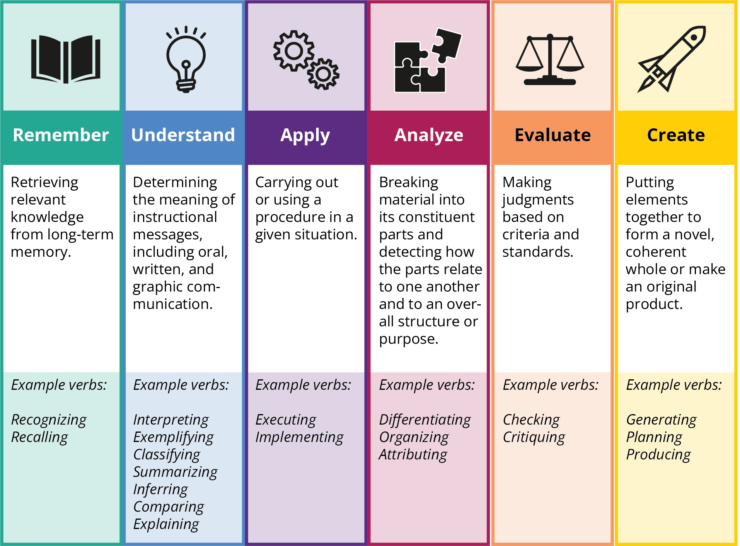Learning goals and Bloom’s Taxonomy
Leerdoelen en de taxonomie van Bloom (Nederlandse tekst)
When teaching, it is important to ask yourself what exactly you want your students to learn. Which subjects do you want to cover, at what level should students master these subjects, and is knowledge the main focus or specific skills, or a combination of both? The learning goals determine the format and the content of the assessment, the assessment criteria, and the grade norms.
Learning goals are also a determining factor for choosing the format and content of your education. As such, proper alignment between learning goals, educational formats, and assessment is needed: the principle of constructive alignment. Thus, learning goals guide both your activities as a teacher and the activities of the students.
Bloom’s Taxonomy

Figure 1. Structure of the Cognitive Process Dimension of the revised Taxonomy of Bloom, Krathwohl (2002)
Learning goals can be formulated on different levels of learning: from lower order thinking and learning to higher order thinking and learning. One way of structuring the different levels of learning is Bloom’s taxonomy (see Krahtwohl, 2002). Bloom’s taxonomy is divided into six levels: remembering, understanding, applying, analysing, evaluating, and creating. The levels serve to differentiate in complexity of the knowledge level required. It does not describe an order in which certain levels should be addressed. Rich learning activities should address multiple levels. (Source (in Dutch): talentstimuleren.nl). It is a misconception that the lower levels should be addressed in the first years of a programme and the higher levels in the later years and the master. Bloom’s Taxonomy is about the level of thinking and learning of the student. Even in the first years of a programme, you want students to do more than remembering subject matter. You specifically want them to be able to apply and use the knowledge they have gained.
Formulating Learning goals
Bloom’s taxonomy can, among other things, be used as a tool for formulating learning goals and related actions and products with which they can be assessed. It is useful to formulate learning goals on different levels of Bloom’s taxonomy for a course. Three key factors are involved:
Content: what does the learning goal cover?
- delimited part of the subject matter
- unambiguously formulated
Behaviour: what should the student be able to show at the end?
- observable behaviour (verb!)
- concrete
Situation: where and in which circumstances?
- Complexity, time, level of autonomy, …….
When formulating a learning goal be sure that the learning goal meets the following criteria:
- Testable, concrete
- Verb (precise)
- Short sentences, simple language use
- One verb per learning goal
- Increasing in target level (See Bloom’s taxonomy)
DON’T use words such as ‘understands’,‘knows’, ‘appreciates’, ‘is familiar with’, ‘has gained insight in’, ‘is aware of’ when formulating learning goals. A tip is to use the following format: ‘After finishing this course the student is able to…’. You will see that you are forced to think in active verbs and consider what exactly the student should be able to do at the end of the course.
Further reading
You can find a lot of literature and examples on the internet on the topic of formulating learning goals using active learning activities. Below you’ll find several links and documents (all in Dutch):
- Formuleren van Leerdoelen– Hilde ter Horst en Riet Martens (aan te raden, bevat ook voorbeelden van leerdoelen)
- Werkwoorden bij beheersingsniveau van Bloom
- Herziene Taxonomie van de leerdoelen van Bloom– van de Kamp, Universiteit van Amsterdam

